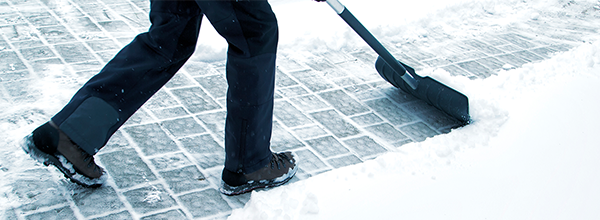Share 10 ways to keep employees safe from cold weather work hazards
When the thermometer dips close to 32 degrees or below, employers need to help outdoor workers add a layer of safety (no pun intended). Outdoor activities in freezing temperatures bring about a number of cold weather work hazards that employers can help mitigate, so share these tips with your commercial lines clients.
While your business owners can’t control the weather, they can control many risks faced by employees. And they don’t necessarily have to spend a lot to reduce or even eliminate many cold weather work hazards.
Even workers with occasional outdoor tasks such as shoveling snow off walkways, deicing entries, clearing rooftops or driving in snowy or icy weather may need reminders of winter safety tips. Whether workers are delivery drivers, construction workers, groundskeepers or are involved in a myriad of other work tasks, you can help them stay safe and healthy by passing along these 10 tips.
Cold weather work hazards around their building
1. Clear ice and snow from parking lots, walkways, entries. This is an obvious place to start: Ensure that employees (along with visitors) entering the building can do so without slip/trip/fall hazards. State laws vary as to whether injuries in outdoor areas are compensable through workers’ comp; regardless, making them safer can protect your employees as well as vendors and other visitors to your business. Use absorbent mats at entrances and post Caution: Slippery Floor signs.
Workers such as delivery drivers or those who help load vehicles should be instructed to wear footwear with good traction, such as slip resistant shoes or boots. In fact, a pair of insulated and water-resistant boots with good rubber treads is a must for walking during or after a winter storm. Remind them that taking shorter steps and walking slower can help them react better to sudden slippery spots. For all other workers, you might suggest that they keep a pair of rubber overshoes with good treads that fit over their street shoes at their desk or in their locker during the winter months.
2. Shovel snow safely. Snow shoveling is a strenuous activity, not only because cold weather can be taxing on the body. There’s also the potential for back injuries, exhaustion or heart attacks.
Workers should start slowly by scooping small amounts of snow at a time. Where possible, they should push snow instead of lifting it. Using a proper lifting technique is necessary to avoid back and other injuries when shoveling snow:
- Keep the back straight
- Lift with the legs
- Don’t turn or twist the body
Additionally, workers should be encouraged to take frequent breaks in warm areas.
3. Using snow removal equipment. If your entity uses powered equipment such as snow blowers, remind workers to ensure the equipment is properly grounded to protect from electric shocks or electrocutions. During equipment maintenance or cleaning, the equipment should be properly guarded and disconnected from power sources.
Snow blowers can cause lacerations or even amputations when workers try to clear jams while the equipment is running. Remind workers to
- Never attempt to clear a jam by hand.
- Turn the snow blower off and wait for all moving parts to stop.
- Use a long stick to clear wet snow or debris from the machine.
- Keep hands and feet away from moving parts.
Snow blowers should be refueled before starting the machine. Never add fuel when the equipment is running or when the engine is hot.
4. Clearing snow and working at heights. Prior to tackling snow removal on heights, employers should look for potential hazards and explain to workers how to do the work safely, staying alert for these unexpected hazards caused by weather conditions. For example, layers of black ice can form as the temperature drops, making slippery surfaces even more dangerous because the ice is unseen. Snow-covered rooftops can hide fall hazards such as skylights. Then there are electrical hazards presented by snow removal equipment or overhead power lines.
Any surface weighed down by snow should be inspected to determine whether it’s structurally safe for workers to access it, because it may be at risk of collapsing. When in doubt, use snow-removal methods that don’t involve workers going on roofs.
5. Using ladders on icy surfaces. In wet and freezing temperatures, even setting up a ladder can be hazardous. Ladders should be placed only on surfaces that have been cleared of snow and ice. Workers should be trained on personal fall arrest systems and methods. Consider using outside vendors who are better equipped and trained to remove snow from roofs and other areas. Employers should determine the right type of equipment, such as ladders or aerial lifts, and personal protective equipment (PPE), such as personal fall arrest systems, for the job and ensure that workers are trained on how to properly use them.
Cold weather work hazards on the road
6. Winter driving. Although employers can’t control roadway conditions, they can promote safe driving behavior by ensuring that their workers recognize the hazards of winter weather driving and are properly trained for driving or operating equipment on snow or icy roads.
It’s particularly important during winter months that employers implement an ongoing maintenance program for all vehicles and mechanized equipment that workers are required to operate. Be sure employees are properly trained to inspect vehicle systems (brakes, tires and the exhaust system) to determine they’re working properly, making immediate repairs if they aren’t.
On-the-road workers who are out in winter weather should carry emergency kits that include the following, says a winter tips article from PropertyCasualty360:
- Cell phone or two-way radio
- Windshield ice scraper, snow brush and shovel
- Flashlight with extra batteries
- Tow chain
- Traction aids (bag of sand or cat litter)
- Emergency flares and first-aid kit
- Jumper cables
- Snacks and water
- Road maps
- Blankets and a change of clothes
7. Stranded in a vehicle. The winter safety article also provided pointers on training employees on what to do if they’re stranded in a vehicle:
- Stay in the vehicle. Call for emergency assistance if needed, recognizing that response time may be slow in severe winter weather conditions.
- Notify your supervisor of your situation. Don’t leave the vehicle to search for assistance unless help is visible within 100 yards. You may become disoriented and get lost in blowing and drifting snow.
- Display a trouble sign by hanging a brightly colored cloth on the vehicle’s radio antenna and raising the hood.
- Turn on the vehicle’s engine for about 10 minutes each hour and run the heat to keep warm. Also, turn on the vehicle’s dome light when the vehicle is running as an additional signal. Beware of carbon monoxide poisoning. Keep the exhaust pipe clear of snow and open a downwind window slightly for ventilation.
- Watch for signs of frostbite and hypothermia. Do minor exercises to maintain good blood circulation in your body. Clap your hands and move your arms and legs occasionally. Try not to stay in one position for too long. Stay awake, you will be less vulnerable to cold-related health problems. Use blankets, newspapers, maps and even the removable car mats for added insulation.
- Avoid overexertion since cold weather puts an added strain on the heart. Unaccustomed exercise such as shoveling snow or pushing a vehicle can bring on a heart attack or make other medical conditions worse.
Related: The hard, cold facts to prevent winter damage
Other cold weather work hazards
8. Removing downed trees. Clearing downed trees is a critical job during severe winter weather conditions. Property Casualty 360 outlines potential hazards:
- Electrocution by coming in contact with downed live power lines or broken tree limbs that are in contact with downed lines
- Falls from heights
- Injuries from equipment such as chain saws and wood chippers
Workers using chainsaws and chippers to clear downed trees should use gloves, chaps, foot protection and fall protection, along with protection for eyes, hearing and head.
Only powered equipment designed for outdoor and wet conditions should be used. Train employees on the proper use of equipment and tools such as saws and chippers. Make sure equipment has proper guarding; safe guards must never be bypassed. All controls and safety features must function as designed by the manufacturer.
Ensure that equipment is properly maintained and inspected before use by an experienced worker who can spot any problems with the equipment. Don’t use equipment that is not functioning properly.
9. Working near downed or damaged power lines. As employees clear parking lots and sidewalks, or return to construction projects, they may encounter downed power lines. Train workers to assume that allpower lines are live. Stay clear of lines that have been knocked down or damaged by winter weather. Workers should establish a safe zone that’s some distance away from power lines and report any incidents to the responsible authority. Only properly trained electrical utility workers can handle damaged power lines.
Preparing your employees for cold weather work hazards
10. Help workers prepare for cold weather work hazards. EHS Today provides these tips to pass along to your workers, to help them stay healthy in winter months:
- Eat plenty of carbohydrates and fats for energy and warmth prior to beginning work.
- Stay hydrated. Urine should be a pale yellow, straw-like color, not dark.
- Get enough sleep. Cold weather work is hard and cannot be done on only a few hours of sleep.
- Remove any wet clothes immediately. They cause accelerated heat loss and impair movement.
- Insulate your head and neck well, as these areas lose the most heat more quickly.
- Wear proper winter clothing that insulates from the cold and lets perspiration evaporate while protecting from the wind, rain and snow. Don’t wear cotton next to the body, as it holds moisture in and makes you colder.
- Protect feet and toes. Wear two layers of socks with a pair of well-fitted boots that come above the ankle.
- Hand protection is vital. Glove warmers plus gloves provide the best protection.
This article was first published in Arrowhead’s Tribal blog. It has been modified to provide winter work tips for our commercial lines producers to share with their business owners.
Additional resources:
Cold Environments – Working in the Cold
Cold Stress

